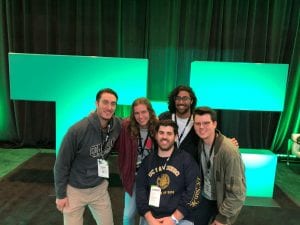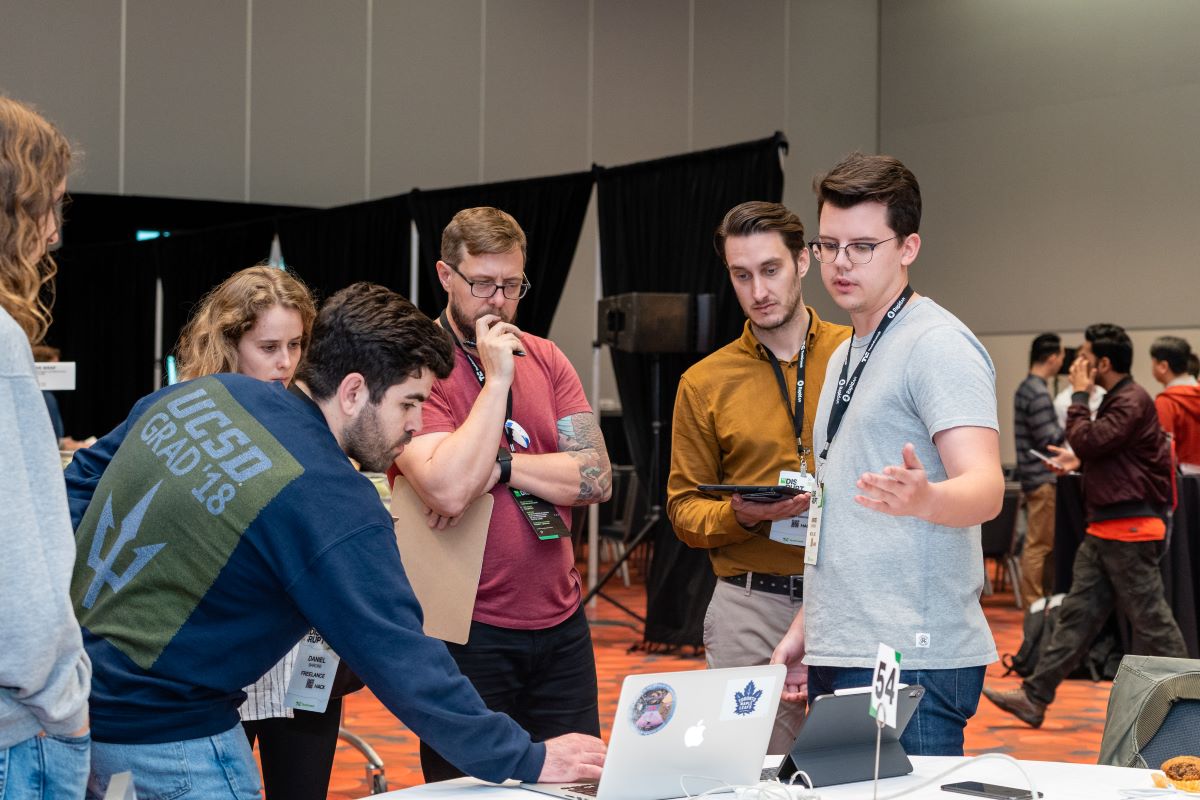What’s it like competing in the headquarters of global tech? Computer Systems Technology (CST) Diploma students Dawson Verboven, Brodie Heywood, Andrei Muresan, and Chirag Fernandez spent some time this month finding out.
The four students, joined by fellow developer and friend Daniel Barone, decided to take the plunge and sign up for the TechCrunch Disrupt San Francisco conference, and managed to get accepted into the event’s hackathon. Disrupt hackathons have had significant success – as one of the biggest startup conferences in the world, it’s seen some overnight creations ultimately being acquired for large sums.
This year’s hackathon sold out with 800 participants. After an exhausting two days of working on a solution, teams had two minutes to present to judges in a science-fair style.
Final round pitch yields second place finish
Ten finalist teams were invited to the next round: a demo on the Extra Crunch stage. The students, currently in CST third term, made it into the finalist group.
After pitching their idea Antibiogram: Powering the fight against superbugs with real-time data on stage, they placed second place.
The team worked with a sponsor company during the event, using their proprietary database technology to power the demo application and making some connections along the way.
Improving healthcare with data
The team’s idea takes on a significant societal challenge of our time: antimicrobial resistance and the rise of superbugs. A recent study commissioned by the British government predicted antimicrobial resistance will overtake cancer as a cause of death by 2050.
Their creation connects doctors to the latest data, making it easier for healthcare providers to prescribe appropriate antibiotics and to avoid the dangers of over-prescription. They built in granular filtering features, as well as the ability to narrow location down as far as a hospital wing.
Team member Brodie explains, “Healthcare continues to be a very important issue. There were so many good ideas at the competition that we feel very lucky to have been noticed by the judges, but it might have been because we chose to focus on health.”
He adds, “Daniel Barone had this fantastic idea for an application. Dawson and Andrei did such an incredible job of presenting it. We really think that antibiograms are important and useful and I think that’s what helped us place.”
Scientists predict that, over the next four decades, anti-microbial resistance will overtake cancer as the leading cause of death.
Taking their computing skills international

Dawson, already a leader as student Chair of the Downtown Campus, says part of the motivation for going was to inspire more students to take risks, and network in environments that are out of their comfort zones. They have all completed hackathons before, which they recommend for the learning experience. They enjoyed applying the skills learned in CST in a competitive environment.
“We wanted to see how hard the competition was at a much larger event,” explains Dawson.
“We pretended that we were trying to start a company,” says Brodie, “and it started to feel like a real possibility.”
Listen to Dawson and Andrei talk about this medical data app with Lynda Steele on the CKNW Lynda Steele Show.
Hackathon advice from BCIT student Dawson Verboven
- If you’re thinking about participating in an event like this, just sign up — you’ll have plenty of time to work on your technical skills by the time the event actually rolls around.
- Do a practice hackathon with your team members before you go, because everything about working together becomes harder when you’re in a new city and a more competitive environment.
- Spend lots of time during the hackathon developing the idea and the product. Don’t rush to the next steps until every member is 100% on board with the plan and you can all summarize what you’re building and why it’s better than the existing solutions. We spent a full 28 hours to ideate before we even touched our code.
- Take advantage of the sponsors/mentors on site if there are any. Bounce ideas off of them and ask detailed questions about their products — don’t plan to integrate with any technologies if you don’t feel you need or understand them.
- Communicate with your team — it’s okay if you’re not operating at 100% the whole time, just make sure others know how to support you.
- Make sure you have some sort of team structure, Front end lead, backend lead if you can coordinate that.
- Prepare for questions about product valuation and profitability, even if that’s not your immediate focus.
Spend lots of time during the hackathon developing the idea and the product. Don’t rush to the next steps until every member is 100% on board with the plan and you can all summarize what you’re building and why it’s better than the existing solutions ~ advice from Dawson and the team
Most important goal
“Remember to have a good time and explore opportunities outside of the competition itself,” emphasizes Andrei.
“Some of my favourite memories come from events that happened outside of the competition – we made new friends and had such a good time in San Francisco and the Bay Area,” laughs Brodie. “We’re very grateful to BCIT and the BCIT Student Association Student Competition Fund committee for their amazing support; without them, our trip would not have been such a success.”
Future plans
“We’re definitely going to compete as a team again, be it at Disrupt next year or at another event,” says Dawson.
“I think we’ve become a really close team,” says Brodie, remembering long days coding together in a small hotel room in San Francisco.
Keep up with the latest from BCIT Computing by signing up for Tech It Out quarterly newsletter.

This is amazing Dawson!
Congratulations to the team! A fun and valuable experience bringing an innovative technology-based approach to a real world problem.
What an achievement, congratulations to these students!